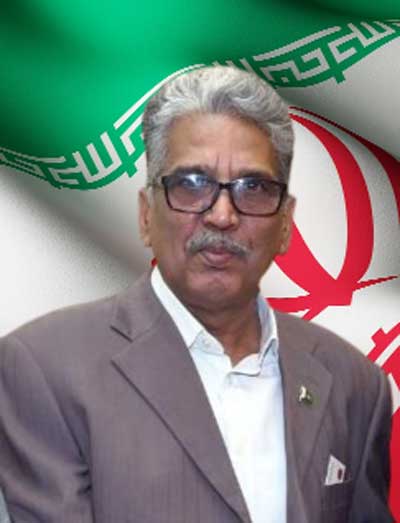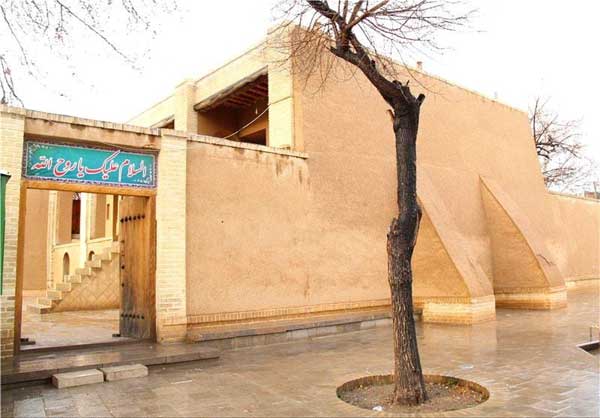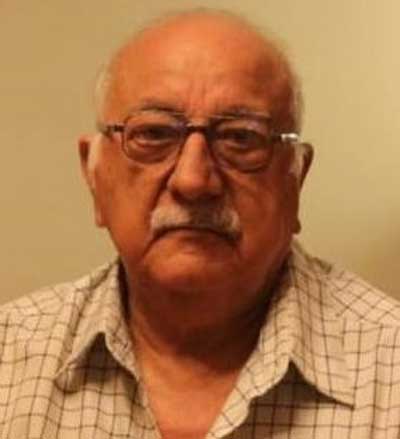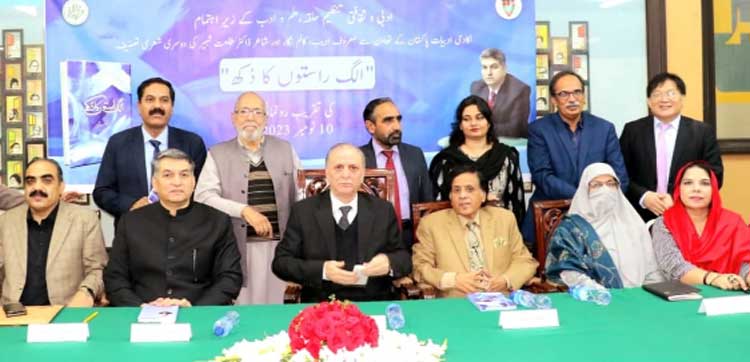

Our journey through Iran on the third day of our week-long visit, accompanied by Ali Fatmi, took an intriguing turn as we embarked on a pilgrimage to the residence of the revered Ayatollah Ruhollah Khomeini. This modest dwelling, comprising just two bedrooms on around 60 square yards, is situated in Tehran, and it bears immense historical and cultural significance. After the Islamic Revolution of Iran, Ayatollah Khomeini chose to live in this unassuming abode, symbolizing his commitment to simplicity and the values of the Islamic Republic.
Our visit commenced with a hearty breakfast that fortified us for the upcoming exploration. Following this, we embarked on a walk through the labyrinthine streets of Tehran, ultimately arriving at the residence of Imam Khomeini. The journey was not without its challenges, as the narrow, winding streets posed quite a navigation puzzle. However, the anticipation of what lay ahead fueled our determination.
Upon arriving at Imam Khomeini Street, where the residence is located, we were subjected to thorough security checks, a testament to the reverence with which this place is regarded. The stringent security measures serve to protect both the memory of Imam Khomeini and the countless pilgrims and admirers who visit to pay their respects and gain deeper insights into Iran’s modern history.
The Residence of Imam Khomeini itself is a place of profound historical importance. It stands as a testament to the ideals of the Islamic Republic, offering a poignant glimpse into the life and teachings of the iconic leader. Total the modest living quarters, sparsely furnished with just two bedrooms, provide a stark contrast to the opulence often associated with leaders and dignitaries. It is a place where simplicity and humility reign supreme, reflecting the very essence of Ayatollah Khomeini’s character.
For visitors, the residence serves as a tangible connection to the Iranian Revolution and the guiding principles upon which the Islamic Republic was founded. Pilgrims and admirers from all over the world flock to this sacred site to pay their respects, learn about the life of Imam Khomeini, and gain a deeper understanding of the historical context that led to the formation of the Islamic Republic of Iran.
At the conclusion of our visit, Asrar Askar Khani, the head of The Institute for Compilation and Publication of Imam Khomeini’s Work, graciously presented us with several books authored by Imam Khomeini. These invaluable texts provide profound insights into his thoughts, teachings, and vision for Iran and the world. Mr. Khani also took the time to brief us about the history and significance of Imam Khomeini’s residence, promising to share more detailed information in the near future.
Our visit to the Residence of Imam Khomeini was a moving experience that deepened our understanding of Iran’s history and the enduring legacy of Ayatollah Ruhollah Khomeini. It is a place where simplicity and conviction converge, serving as a powerful reminder of the ideals that continue to shape the nation to this day.
The second stop on our journey along this street was The Institute for Compilation and Publication of Imam Khomeini’s Works, which we visited prior to Imam Khomeini’s house. This institute stands as a prominent institution with a noble mission: to preserve and disseminate the teachings and literary works of Imam Khomeini. It serves as a central hub for research, translation, and the publication of Imam Khomeini’s invaluable contributions to literature.
Within the institute, the International Affairs Department plays a pivotal role in propagating the message of Imam Khomeini on a global scale. Its primary objectives include promoting interfaith dialogue, facilitating a deeper understanding of Iran’s Islamic revolution, and fostering a sense of unity and cooperation among diverse cultures and beliefs. Scholars, researchers, and enthusiasts from around the world are drawn to this institute, all seeking to immerse themselves in the profound intellectual legacy left behind by Imam Khomeini.
Exploring the Historical Residence of Ayatollah Ali Akbar Hashemi Rafsanjani
Before our visit to the institute, our first stop along this street was the Residence of Ayatollah Ali Akbar Hashemi Rafsanjani, an iconic historical landmark situated at the very corner of the street. This residence holds immense significance in Iranian history due to its association with the late Ayatollah Rafsanjani, a pivotal figure in Iranian politics. Our visit to this house not only provided a unique glimpse into the life of this influential leader but also shed light on his immense contributions to the country. Inside the residence, an array of personal artifacts, photographs, and documents offered invaluable insights into Rafsanjani’s political career and the indelible mark he left on Iran’s political landscape. This museum stands as a fitting tribute to Rafsanjani’s enduring legacy and serves as an educational platform where visitors can delve into the complex political dynamics of Iran during his tenure.
The two-story structure that houses the Residence of Ayatollah Rafsanjani is a striking architectural gem in its own right. Its presence at the street corner commands attention, and its historical significance is instantly apparent. As we entered the house, we were greeted by a remarkable Vax sculpture of Rafsanjani on both floors. The sculpture is so lifelike that it creates the illusion that Ayatollah Rafsanjani himself is welcoming visitors into his home. This thoughtful touch adds a sense of personal connection, making the visit all the more immersive.
Walking through the halls of Rafsanjani’s residence, it became evident that this place was more than just a museum; it was a journey through the life of a statesman who played a pivotal role in shaping Iran’s political landscape. The personal artifacts on display, from the meticulously preserved clothing to the items used in his daily life, provided a sense of intimacy with the man behind the politics.
Photographs and documents showcased pivotal moments in Rafsanjani’s political career, allowing visitors to trace his remarkable trajectory from his early involvement in the revolution to his ascendancy in the Iranian political hierarchy. These visual aids served as a powerful reminder of the transformative period in Iran’s history during which Rafsanjani played a central role.
One cannot fully appreciate the impact of Ayatollah Rafsanjani on Iran without visiting this residence. The exhibits offer a nuanced understanding of his pragmatic and progressive approach to governance. His role in stabilizing the country’s economy and promoting social reforms becomes evident through the documents and policies he championed.
Moreover, the residence provides insight into the relationships and networks that Rafsanjani cultivated on the international stage, shedding light on Iran’s foreign policy during his tenure. This broader perspective helps visitors grasp the complexities of Iran’s political landscape during a critical period in its history.

Residence of Rafsanjani stands as a testament to the life and legacy of a remarkable political figure. Its role as a museum not only commemorates his contributions to Iran but also offers an engaging educational experience for visitors interested in understanding the intricate web of Iranian politics. The lifelike Vax sculpture that greets visitors adds a personal touch to the experience, making it a must-visit destination for anyone seeking to delve into the history of Iran and the enduring influence of Ayatollah Rafsanjani.
Now you will enjoy the Nazir Leghari thoughts in English version which had published earlier in Urdu.
Today, Muhammad Raza Shabani didn’t come. Today, Ali Fatemi and driver Muhammad Bhai have arrived. After finishing breakfast, everyone goes to their rooms, and we gather in the car. Now, we are heading towards Jamaran.
I am visiting this area after approximately 22 or 23 years. The first time I came here, the Karachi Consulate of Iran arranged this trip with the efforts of Brother Shahenshah Jaffery. It was a large group that included Senator Waqar Mehdi, Senator Masroor Ahsan, Agha Masood Hussain, Mushtaq Ahmed Faridi, Habibuddin Junaidi, Salim Burhan, Mehdi Hasan, and other friends.
Jamaran is located at the foothills of the Koh-e Alborz mountain range, and our hotel is also situated in the Koh-e Alborz foothills. The distance between the hotel and Jamaran is approximately 7 kilometers. When we first visited Jamaran, at that time, the narrow alley was the only way to get there, but now, that alley has been expanded.
Previously, this alley was significant because it housed a small two-room house where Ayatollah Khomeini, the leader of the Iranian Revolution, used to reside after the revolution. Additionally, there was Hosseiniyeh Imam Bargah in this area, where Ayatollah Khomeini used to meet the public and dignitaries, and in the same neighborhood was the hospital and the bed where Ayatollah Khomeini passed away. Now, that house has been converted into a museum.
We are told that when Ayatollah Khomeini started the revolutionary struggle in Najaf, Iraq, there used to be secret communication between a five-member Supreme Council in Iran and the leadership in Najaf. Ali Akbar Hashemi Rafsanjani was the head of this highest council. During the peak of the revolutionary struggle, five more members were added, including the current Supreme Leader of Iran, Ayatollah Khamenei. Before the revolution, this ten-member revolutionary council, under the guidance of Ayatollah Khomeini, was leading the revolution, and Ali Akbar Hashemi Rafsanjani was its head.
Ali Akbar Rafsanjani was from the central district of Rafsanjan in the province of Kerman, Iran. According to the 2016 census, the population of Rafsanjan city was around 162,000. Rafsanjan is located 875 kilometers southeast of Tehran and 570 kilometers northeast of Isfahan.
In the alley of Jamaran, there is another addition, known as the Imam Khomeini’s Wonderland House. We leave the car before the narrow alley and start walking ahead. Previously, we had to walk quite a distance on foot before starting this journey, and even international diplomats had to walk on foot to meet Ayatollah Khomeini in Iran. We were told that even the last Soviet leader, Mikhail Gorbachev, had to walk on foot to reach Ayatollah Khomeini’s house in this alley.
After a short walk, our guide Ali Fatemi stops in front of a house and tells us that this is Ali Akbar Hashemi Rafsanjani’s house. After the revolution, Ali Akbar Hashemi Rafsanjani became the fourth President of Iran. The first president of Iran was Abolhassan Banisadr, who was the son-in-law of the current Supreme Leader, Ayatollah Khamenei. He was the Foreign Minister in the interim revolutionary cabinet before becoming president. Later, after becoming the president, he was accused of betrayal during the revolution and fled the country to France. Mohammad Ali Rajai, who was elected as the second president, was martyred in a suicide attack on the parliament on August 30, 1981. Nearly 70 members of parliament were also killed in that attack. At the time of the attack, Ayatollah Khamenei, who later became the Supreme Leader, was the Prime Minister. After Khamenei, Ali Akbar Hashemi Rafsanjani was elected as the third president of Iran. During Rafsanjani’s presidency, Iran-Iraq War began, which you have read about during your previous visit to Iran.
Imam Khomeini Museum
After walking a few steps from President Hashemi Rafsanjani’s house and museum, we reach the entrance of Imam Khomeini Museum. Here, the revolution appears as a documentary testimony. Here, you witness the revolution as it unfolded during a time when no one could have imagined its success.
As we enter the Imam Khomeini Museum, the first thing that catches our eye is a painting. In the painting, Ayatollah Khomeini is seated on a chair. He is wearing a long robe, and his head is covered with a black turban. Behind him stands his son, Ahmad Khomeini. Both are dressed alike. The background of the painting is very beautiful.
Another image represents their youth. Most of the images here are in black and white. The images of their youth depict the time when the anger and dissatisfaction of the Iranian people against the Shah’s tyranny and oppression began to take on revolutionary colors. In these youth images, Ayatollah Khomeini can be seen addressing public gatherings. In some images, he is seen conversing with scholars and students. Then there are images from the time of the revolution. These images include Ayatollah Khomeini’s journey from Paris to Tehran, where Shah had already fled. The state’s power has been entrusted to Ayatollah Khomeini’s revolutionary comrades. Mehdi Bazargan has been appointed as the Prime Minister. He was a renowned Iranian scholar, teacher, educator, and a soldier of the republican struggle. He was born in Tehran, died in Zurich, and was buried in Qom. He remained active in the movements for the liberation of Iran, the National Front, and the Iran Party. After the success of the revolution in February, Ayatollah Khomeini nominated him as the Prime Minister.
From the images in the museum, one can estimate the pace of the revolution from the enthusiasm and excitement of the people. Every revolution is a realization that when people decide to take matters into their own hands, no power in the world can stop them. One image shows Iran’s current Supreme Leader, Ali Hosseini Khamenei, sitting with Ayatollah Khomeini and other scholars. Another image shows Ali Khamenei presenting a document to Ayatollah Khomeini. There is also a picture where, after the revolution, the then-President Mohammad Ali Rajai and Prime Minister Ali Khamenei are seen consulting with Ayatollah Khomeini.
In one image, Ayatollah Khomeini is seen meeting with a delegation of women, reminding them that the success of the revolution was not possible without the active participation of women.
In the museum, there is a framed piece of Ayatollah Khomeini’s Persian poetry. He was not only a leader of the revolution but also a prolific Persian poet. You can read his poetry, and I will provide a translation to help you appreciate his poetry. By reading his poetry, you will get to know his poetic side better.
Mr. Israr Asghar Khani takes us a few steps away, bringing us to this Imam Bargah located right in front of Ayatollah Khomeini’s house, where he used to meet local and international delegations and individuals regularly. We all enter this Imam Bargah. After entering through the main door, there is a large screen on the right side, while directly in front, there is a stage built at a certain height. However, the path to this stage is constructed from behind the building. To access the stage, there is a large rear door, which serves as the second entrance to this building, but it allows direct access only to the stage. Ayatollah Khomeini used to enter this Imam Bargah through this door. He would come straight to the stage, walking across a bridge-like platform from his house to reach here. This stage resembles a balcony.
There are three columns in front, with one column slightly set back. Ayatollah Khomeini usually came here with his son or other important figures and sat on a chair placed on the stage. On this stage, his son or other significant personalities would sit on a carpet and listen to his speeches or discussions.
We had previously sat at this same location listening to speeches and witnessing images of other Iranian figures, such as President Mohammad Ali Rajai and Ayatollah Khomeini’s son, Ahmad Khomeini.
This Imam Bargah has a balcony-like structure on three sides, where arrangements were made for women to sit and listen to Ayatollah Khomeini’s speeches or discussions. This Imam Bargah cannot be described as a large building or hall.
Israr Asghar Khani is known here for running a film that features Ayatollah Khomeini giving a speech inside this hall. Nowadays, with the advent of computer networks, Ayatollah Khomeini’s speeches often start with a PowerPoint presentation. I’ve heard many of his speeches on the internet already. When we listen to Ayatollah Khomeini, it’s clear that we either understand his spoken Persian, or we rely on the translations of individuals like Zain Naqvi, Ali Fatemi, and Israr Asghar Khani. The most powerful element of these speeches is the resonance of their voices and their dialect.
Whether a revolution is imminent or has already occurred, its real dynamics depend on the prevailing conditions in the area and the overall response of the people to those conditions. Revolutionary leadership then makes informed decisions about the direction of the revolution based on a solid analysis, policies, practical wisdom, and actions. These decisions determine the course and outcomes of the revolution. In these circumstances, the revolution takes the form of a grinding machine for stones, crushing anything that comes in its way. From the University of Tehran to Freedom Square, and from there to different corners of Iran, we have seen the revolution advancing with full force, breaking barriers, and challenging anything in its path.
Ayatollah Khomeini opposed the “White Revolution” in Iran vehemently and was arrested in 1963 in Qom for his strong opposition. Shah of Iran eventually exiled him to Turkey. Initially, he was taken to Ankara, and later he was sent to another Turkish city, Bursa. Bursa was Turkey’s fourth-largest city and held significant importance during the Ottoman Empire. On September 5, 1965, he left Turkey and arrived in Najaf, Iraq. After the revolution, he stayed in Qom for a few days, but due to heart problems, he had to move to Tehran.
In Tehran, he arrived on January 23, 1980, and the doctors suggested that the climate in Qom was not suitable for his health, so he chose Jamaran as his residence in Tehran. There, he opted for a small and modest house. I visited this house for the second time, 23 years later. At that time, the two rooms of the house were open, but now they are closed. There seems to have been some renovations in recent years.
When I first visited, we were taken to a nearby hospital, where we saw a small room assigned to Ayatollah Khomeini and the bed where he spent his final days and took his last breath. The first time, we were shown the bed where he used to rest. Later, we walk with Israr Asghar Khani outside the house to the bridge-like platform in front of the western room of the house. There, he presents us with a gift of two books, which are Urdu translations of Ayatollah Khomeini’s works. One book is “Tajalliyat-e Tawhid,” and the other is “Tahzib-e Nafs.”






